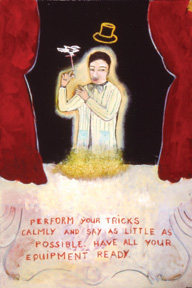|
inez Storer
July 30 -
september 12, 2004
Reception:
Friday,
July 30, from
7:00 to 9:00pm
Artist
Talk:
Thursday,
August 5
at 7:00pm |
|
 |
Personal narrative figures
prominently in Inez Storer’s paintings. She describes her own
aesthetic process as a method of uncovering buried histories.
One of the most important of these histories for Storer’s work
is her Jewish identity. Storer was raised as a Catholic, and the
details of her German-Jewish past were not revealed to her until
her mother was dying. As a result of her unique upbringing,
iconography from both religious traditions often coexist within
Storer’s work. References to Russian folk art within her works
allude to the influence of her husband, Russian artist Andrew
Romanov, who is a grand nephew of a Russian czar. In addition,
Storer’s paintings often depict narratives that unfold against
the allusion of a theatrical backdrop—a direct reference to her
father, who was an aviator and later an art director for
Paramount Studios in Hollywood.
"For more than four
decades, Storer has pursued her own uniquely personal and
idiosyncratic style of figuration,” said Karen Kienzle, curator
of exhibits and collections for the de Saisset Museum of Santa
Clara University in California, where Storer had the first
retrospective of her work. “Storer’s delightfully accessible
works are rich in content, addressing universal themes of
identity, spirituality, imagination, and history.” Storer uses
the figure, gathered fragments of text, iconic metaphors and the
use of symbolic images to define personal narratives. Her
paintings refer to impossible acts of bravery with allusions to
the mysterious nature of individual fate and fortune (or
misfortune). Often there is an allusion to relationships between
the figures which can also be precarious as if on a tightrope –
a sort of psychological dilemma. In fact, there can be a darker
interpretation that takes the work to a deeper level; there is
often an underlying possibility of danger, such as falling,
drowning or unbalance – an emotional precariousness. |